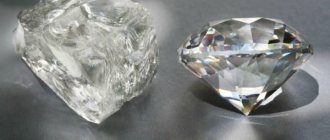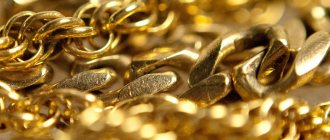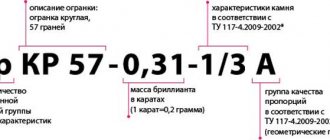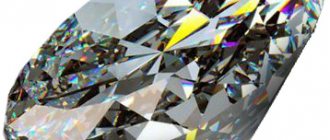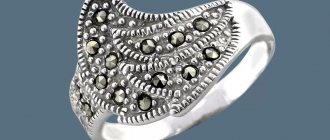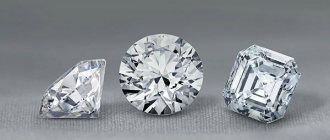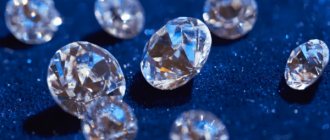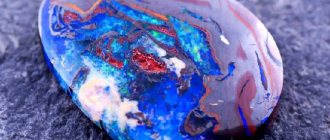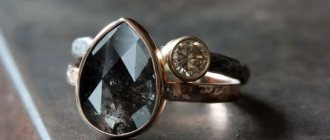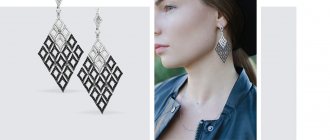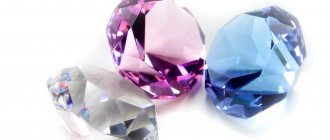Diamond is truly a very unusual stone. In addition to their unique physical and chemical properties, diamonds have interesting external features, which include color. In the vast majority of cases, uncut natural diamonds are rather pale, translucent crystals. And only with the correct cut does an inconspicuous diamond turn into a diamond that plays with “fire.”
For a long time, diamonds were valued much cheaper than rubies, emeralds, sapphires and other bright stones, as well as pearls. Perhaps, if it were not for the exceptional hardness of diamonds, they would not have been paid attention to even longer. Only from the 16th century, with the development of cutting and polishing technologies, diamonds became the main precious stones. And one of the criteria by which the value of a diamond is determined is its color.
Basic colors of diamonds and diamonds
Diamonds acquire their color due to various inclusions and impurities, structural defects or natural radiation exposure. The color of the diamond may be uneven - in spots or areas, or only the top layer may be colored. Sometimes the presence of several colors is observed in one diamond. In nature, the most common diamonds are those painted in pale tones of various colors.
For industrial diamonds and aggregates (bort, carbonado, ballas), which account for almost 80% of all mined diamonds, the characteristic colors are:
- milky white
- gray
- black diamonds
The most common gem-quality diamonds are:
- yellowish diamonds with various shades
- smoky brown, brownish diamonds
Rare flowers are:
- greenish
- bluish
- mauve
Colorless diamonds are very rare. Even if a diamond is colorless, most often you can detect some color tint in it, which experts call “color.” An absolutely colorless and pure diamond is called a stone of “pure water”. You can read about the origin of this name at the end of this article. “Pure water” diamonds are very rare, since in the vast majority of cases the stones have some kind of coloring, impurities or defects.
Physical properties
Diamonds, like rough diamonds, are made up of carbon atoms. The chemical formula of this nugget is C. The atoms are in a certain order, resulting in the formation of cubes. The density of the gem per cubic centimeter varies from 3.47 to 4.55 grams.
According to the Mohs scale, a diamond is considered the hardest substance, as its hardness reaches 10 units. Despite its high hardness, the material is quite brittle and will not be difficult to break. The melting process begins at a temperature of +4000 degrees. If you place a stone in a vacuum, it will burn completely when the temperature reaches +800 degrees.
What colors of diamonds are the most valuable?
The most valuable are diamonds painted in bright, so-called fancy colors, which are extremely rare.
Particularly noted are rich gold and wine yellow diamonds, and even rarer blue, pink, ruby red and cherry colors. Bright green, purple and black gemstone diamonds are extremely rare.
For example, a bright purple-pink diamond of 19.54 carats (center) was cut into an 8.41 carat diamond (right). The diamond was sold in October 2014 at Sotheby's for US$17.77 million.
Magic properties
The magical properties of the stone have been known since ancient times; its energy is so high that it can improve a person’s aura. However, only those gems that were received as a gift or inherited have such properties. If you purchase jewelry on your own, you should not count on such power.
Thanks to its magical properties, the diamond protects the owner from negative influences from others. In addition, such nuggets neutralize damage and all kinds of curses. A person who has such a stone gains self-confidence, becomes much more resilient, and does not experience a feeling of fear.
Advice! Diamond stones can only be worn by those people whose thoughts are pure, who are honest not only with themselves, but also with those around them. If there are evil intentions, the mineral will not only not help, but will also cause serious harm to the owner.
Diamonds of pure water
You often hear the phrase “a stone of pure water” or “a diamond of pure water.” This term refers to perfectly transparent and high-quality stones, mainly diamonds and, accordingly, diamonds. There are different versions of the origin of this term. Perhaps the most ridiculous one is that smugglers hid diamonds in containers of water, in which such stones are supposedly not visible.
In fact, diamonds or diamonds, even the most transparent ones, are clearly visible in water. In order for a substance to be invisible in water, it must have a similar refractive index to it. The refractive index of water is 1, glass is 1.5, and diamond is approximately 2.4. Thus, a diamond is more visible in water than glass, and it is impossible to hide it there. Most likely, the term “pure water diamond” appeared as a designation of uniform transparency and the absence of defects and coloring in the stone, which corresponds to the properties of crystal clear water.
ALL STONES - CATALOG | DIAMONDS (DIAMONDS) - CATALOG
Physical properties of diamond | Chemical properties of diamond | What are the different shapes of diamond crystals? What is a black diamond? | The largest diamonds - the whole list | Huge Diamond - Golden Jubilee | The largest diamond in history, the Cullinan and its diamonds | Meaning assigned to a diamond
Share this article with your friends
Works by designers from the JEWELIRUM catalog
- Co.Cos Jewelry
- Co.Cos Jewelry
- Taiga Jewelry, Tomsk
- Taiga Jewelry, Tomsk
- Ilya Maksimov, Crimea
- Ilya Maksimov, Crimea
- UBIRING
- UBIRING
- Diamonds are Forever
- Diamonds are Forever
- Rings in natural style, Sergacheva Jewelery
- Earrings with pearls, Sergacheva Jewelery
- Cabochon ring, Minty Sky
- Fly earrings, Minty Sky
- Ring, Precious Park
- Ring, Precious Park
- Snake skin ring, Stoyanova Jewelery
- Chain earrings, Stoyanova Jewelery
- Children's pendant - stick, Matthew&Daniel
- Pendant for a child, Matthew&Daniel
- Bracelet, Svetlana Subbotina
- Ring with Slavic symbols, Svetlana Subbotina
- Indian style ring, Anna Goffman
- Indian style ring, Anna Goffman
- Earrings, ISTA
- Geometric ring, ISTA
- Earrings with enamel, PNJewelry
- Ring with enamel, PNJewelry
- Ring, Khramtsova Jewelry
- Ring, Khramtsova Jewelry
- Wedding rings to order, obruchalki.com
- Wedding rings to order, obruchalki.com
- Earrings, Yuri Bylkov
- Earrings, Yuri Bylkov
- Titanium bracelets, LanaMuransky
- Titanium pendant, LanaMuransky
- Brooch Elephant (after Salvador Dali), THING
- Ring Veil, THING
- Mace earrings, VLADIMIR MARKIN
- Cufflinks, jewelry mechanics, VLADIMIR MARKIN
- Drop-shaped ring, EKATERINA TOLSTAYA
- Drop-shaped earrings, EKATERINA TOLSTAYA
- Necklace with amber, LETA
- Earrings with amber, LETA
- Children's earrings, combinable, FASHBY
- Children's earrings, combinable, FASHBY
- Ring of architectural form, Elizaveta Malafeevskaya MANU_L
- Architectural bracelet, Elizaveta Malafeevskaya MANU_L
- Set Ginkgo Leaf, SHABUT JEWELLERY
- Brooch Wearable porcelain, SHABUT JEWELLERY
- Architectural ring, GEOMETRY
- Brooch, porcelain, GEOMETRY
- Necklace made of polymer clay, LICORNE ART
- Brooch made of polymer clay, LICORNE ART
- Ring, avant-garde, VALERY SEREDIN
- Bracelet, avant-garde. VALERY SEREDIN
- Wooden set, Scandinavian/Japanese minimalism, VLADIMIR SHESTAKOV
- Ring, Scandinavian/Japanese minimalism, VLADIMIR SHESTAKOV
- Earrings, TON ANT
- Ring, TON ANT
- Architectural ring, ANCHOR
- Architectural necklace, ANCHOR
- Earrings, GOHFELD JEWELLERY
- Necklace, GOHFELD JEWELLERY
- Massive ring, YAKISCHIK
- Designer jewelry, YAKISCHIK
- Architectural ring, ONE DAY ART
- Architectural ring, ONE DAY ART
- Brooch, bionics, VALERIYA MARKOVA (TESSA)
- Unclosed ring, bionics, VALERIYA MARKOVA (TESSA)
- Ring, bionics, BEAVERS
- Earrings, bionics, BEAVERS
- Earrings, asymmetry, VAGANOVA JEWELRY
- Airplane ring, VAGANOVA JEWELRY
- Flower ring, ALCHEMIA JEWELLERY
- Set, ALCHEMIA JEWELLERY
- Pendant-cat, ethnic, STUDIO OF ILYA AND VERA PALKIN
- Earrings, STUDIO OF ILYA AND VERA PALKIN
Comments
- Anonymous
Thank you !!! You helped me a lot !!!!!!!!!!!!!!!!!
3 years ago Reply
How to choose diamonds?
The purpose of purchasing a gemstone plays a big role. Some people want to make a smart investment, while others buy it as decoration. The cost and value in individual cases differ dramatically.
Gold pendant with cognac and white diamonds, SL; gold earrings with black, cognac and white diamonds, SL; gold ring with black, cognac and white diamonds, SL (prices via links)
For a smart investment, purchase a 1-2 carat diamond with a clarity and color range of 3-6. The cost of such a precious stone is high, but even over time it does not fall due to its high quality.
Purchasing diamond jewelry will require much less money since you need to buy a gemstone with 5/5 characteristics. For a ring, earrings or necklace, a medium or small stone within 0.3 carats is suitable.
Age affects the choice of diamond. The younger the woman, the smaller the size of the gemstone she should buy.
Diamond's properties, beauty, brilliance and depth of color make it a favorite among gemstones. A gift to a woman in the form of jewelry, even with a small precious stone, will delight her with unprecedented delight and give her many positive emotions!
H and I compared to other varieties.
H and I grade diamonds, in the middle of the Near Colorless range, do not have very noticeable coloration, and at the same time, they are not as expensive as more colorless stones. This is why the HI variety is a popular choice for buyers.
However, this does not mean that these stones are colorless. When placed next to D, E or F grade diamonds, HI diamonds will appear slightly more colored, but when viewed individually, they can pass for colorless.
Although someone with truly keen eyesight may be able to detect the faint tint of Near Colorless Diamonds, most people will not notice it.
Stones in the Near Colorless category are those in the lowest range of colors that can pass for white, depending on the setting and lighting.
Once you're past the J grade, the lowest grade in the range, you enter the yellow color spectrum, and stones graded K or lower will have a noticeable tint.
So if you are looking for a white or slightly cream diamond, don't go below the GHIJ range.
Who is it suitable for?
If we turn to astrology, it becomes clear that diamond is correlated with the sun. Thus, a diamond is suitable for all people, but it is important to take into account a number of nuances.
For clarity, you can see which zodiac sign a diamond is most suitable for:
- Aries, Sagittarius, Leo - the gem is best suited for them, since they perceive the outgoing energy, using it for personal purposes.
- Libra, Aquarius - a diamond helps these zodiac signs gain confidence in their own abilities.
- Capricorns – it is recommended to use white or blue diamonds.
- Cancers, Pisces - allows you to organize your thoughts.
- Taurus – preference should be given to black diamonds, which will give confidence.
- Gemini - green stones will improve your health and help improve your financial condition.
- Virgo, Scorpio - any stone will do, except black.
Diamond brings success to people with names like Margarita, Alexander, Victor, Maria.
Hold the diamond in the light
The way real stones reflect light rays is a unique process. A gray-white glow appears inside the stone, and rainbow rays appear outside, reflecting onto other surfaces. In artificial diamonds, the rainbow light appears inside. Some people somehow think that gemstones sparkle like a rainbow, but this is not true. They have a grayish sheen inside. If you see a rainbow glow inside, this may be a sign that you got an artificial stone. However, it may be difficult for a non-specialist to distinguish; it is better to consult an expert.
Important: Consider framing before you buy.
If you decide to buy a Near Colorless diamond, you should know that the metal in which it is set can have a huge impact on whether the stone's hue is noticeable.
The whiter the setting, the more color will stand out in the diamond. Therefore, the lower the color scale of your stone, the less suitable materials such as platinum or white gold will be for setting, and you will need to consider a more colored metal or alloy instead.
In general, if you want to set your stone in a white metal, choose a grade no lower than H. I and J colors will most likely have their slight tint enhanced by metals like platinum or palladium, so if you have a diamond in this color range, yellow gold would be the best choice.
As a final note, you should remember that the cut is very important to how prominent the color of the stone will be.
A good cut can refract and reflect light in a way that masks yellow tones, while a poor cut can make them stand out. This is why you should always judge the appearance of each diamond based on how your eyes see it.
Why is it important to buy certified diamonds?
If the diamond does not have a certificate, you will be relying on the jeweler's statement of its quality. It should be borne in mind, however, that if the stone is assessed by an independent appraiser, its grade may be lower.
Therefore, if you buy a diamond based on the seller's own grading, you may end up paying more than if the stone was certified by the GIA (Gemological Institute of America).
To ensure that you are not overpaying for your diamond, always buy stones that are certified by an established body.
Otherwise, you will be paying for quality that has not been verified by an independent appraiser, and the seller's personal assessment may always be biased, even if it is not a misrepresentation.
What does cutting affect?
Diamond cut is an extremely important characteristic. Although this is not always taken into account by buyers, there are experts who consider cut to be the most important quality characteristic of a diamond.
A properly cut diamond will have maximum brilliance and sparkle. Using cutting, the diamond's facets are shaped so that incoming light is well refracted, reflected and sparkles with all the colors of the rainbow. There is a certain ideal cut that serves as a template for assessing the quality of the cut.
The closer the cut is to ideal, the better the play of light characteristics the stone will have. The cut should be proportional and symmetrical, which will enhance the shine, which, in turn, will mask some of the natural defects of the stone.
It is clear that poorly cut stones will not be able to hide a low level of purity well. On the contrary, they can even highlight these shortcomings.
What should you pay attention to when choosing a diamond?
You need to choose a diamond without focusing on one particular parameter, but considering all three characteristics together - color, cut and clarity.
Generally, high quality diamond color and cut can improve poor clarity. But this plays a role when the clarity of the stone is SI2 and lower (i.e. inclusions are visible even without a magnifying glass).
If the clarity of the stone is higher than SI1, then such inclusions cannot be seen without a magnifying glass with tenfold magnification or under a microscope. Therefore, there is no point in masking or hiding such defects.
When choosing the clarity of a diamond, do not look for the highest grade, because... good color and correct cut will easily hide visible imperfections. However, a diamond with excellent clarity but a poor cut will look worse than a stone with an excellent cut but poor clarity.
The main thing is that the purity should be in the range in which inclusions are noticeable under a magnifying glass, but not visible during normal examination. Having saved on the clarity of a diamond, it is better to pay this money for a very good cut and color.
The quality of the cut should be selected from “good” and above (“very good” and “ideal”) on the GIA scale. When choosing a color, it is best to pay attention to those diamonds that do not have a visible shade (not lower than the “J” color).
And it is also important in what frame you plan to wear this stone. If the item is made of yellow gold, the stone will still appear to have a slight yellow tint.

